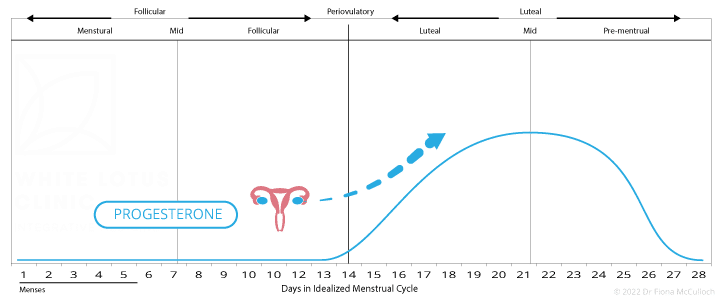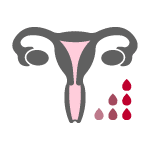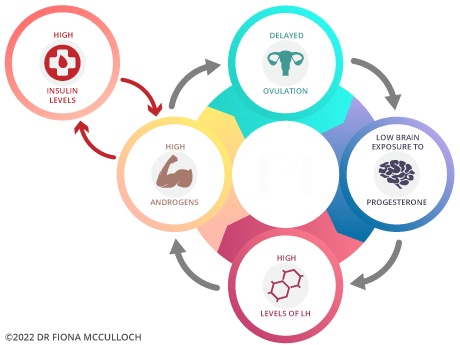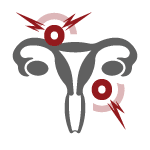The Benefits of Cyclic Progesterone Therapy
What is Progesterone?

Progesterone is the natural hormone released by the ovary, after ovulation occurs. Levels of progesterone are high for approximately two weeks after ovulation, after which they drop to a low level, inducing the next period.
Progesterone is a natural hormone and is different from synthetic PROGESTINS, which are commonly prescribed in birth control pills, hormonal IUDs or in other similar medications. Synthetic progestins have more risks and don't provide the same benefits as natural progesterone.
Despite research confirming the clear differences between progesterone and progestins, it’s still common for practitioners to think of them as the same.
Natural progesterone acts as a natural anti-androgen, reduces levels of LH and is an important factor in the communication between the brain and ovary in the process of healthy ovulation.
Symptoms of Low Progesterone
If progesterone is too low it can cause
- Heavy periods
- Painful Periods
- In patients with PCOS and excess of testosterone: unwanted hair growth, androgenetic hair loss, irregular cycles
- Premenstrual syndrome
- In perimenopause: insomnia, irritability and anxiety
- Fertility concerns like miscarriages or implantation failure
- Inflammation (progesterone is anti-inflammatory)
What is Cyclic Progesterone Therapy
Cyclic progesterone therapy involves taking natural progesterone at bedtime for 2 weeks “off” and 2 weeks “on” every month. This follows the natural pattern of hormone production and can help reestablish normal hormonal balance. At the end of the 2 weeks “on” patients will typically have a menstrual bleed and the cycle begins again.
Cyclic progesterone therapy is generally given for a minimum of 3 months and in many cases for longer.
In our Toronto clinic, our naturopaths prescribe cyclic progesterone in the form of natural micronized progesterone suppositories.
Cyclic Progesterone and PCOS
Cyclic progesterone therapy works at the level of the brain in PCOS, to help manage levels of testosterone and androgens.
Women with PCOS often have low levels of progesterone as they do not ovulate regularly, and therefore don’t make enough of this hormone. Cyclic progesterone therapy reduces levels of LH by slowing the pulsation of GNRH(1), hormones produced by the brain that regulates how the ovary makes hormones.
When repeated in consecutive cycles at the correct dose, most patients experience a reduction in LH and androgens or testosterone levels along with their androgenic symptoms of PCOS.
Since androgens like testosterone are often involved in blocking ovulation, many PCOS patients begin to ovulate with this treatment.
Progesterone can also prevent endometrial hyperplasia and atypia as it induces withdrawl bleeds.
The most common prescription to induce withdrawal bleeds in PCOS is NOT natural progesterone it is actually a synthetic progestin: medroxyprogesterone commercially known as Provera. Withdrawal bleeds can also be achieved with natural cyclic progesterone.
Since androgen excess is the underlying cause of insulin resistance in PCOS, cyclic progesterone can also support the management of insulin resistance and a healthy metabolic rate.
Cyclic Progesterone in Perimenopause and Menopause
Cyclic progesterone therapy has many applications for perimenopause. It can lighten the problematic heavy menstrual cycles that are common in this phase of life. It can support deeper sleep and help to manage mood, anxiety and irritability.
In menopause, cyclic progesterone therapy can improve:- bone density
- sleep
- mood
- hot flashes

Cyclic Progesterone for Heavy or Painful Periods

One of the most consistent benefits of cyclic progesterone therapy is that it can lighten heavy periods also known as menorrhagia. Progesterone opposes the effect of estrogen on the lining, keeping it in check and reducing heavy bleeds.
Cyclic Progesterone for Endometriosis
Endometriosis is a whole-body inflammatory condition where cells similar to those which line the uterus are found in different locations in the body. Patients with endometriosis can have a variety of symptoms including fatigue, menstrual pain, painful intercourse, and bowel symptoms just to name a few. Due to its antiinflammatory effects, cyclic progesterone therapy can support many of the symptoms of endometriosis and may reduce the excessive overgrowth of these cells(3).
We have found that many patients seeing us for endometriosis treatment in our Toronto clinic improve with cyclic progesterone therapy.
Cyclic Progesterone and Female fertility

Progesterone is required to support the implantation of an embryo within the endometrial lining. Low levels of progesterone have been linked to miscarriages. Progesterone exerts anti-inflammatory effects which are likely crucial for healthy implantation and pregnancy(4). Progesterone may be more important for patients with inflammatory or autoimmune conditions who are trying to conceive.
When given for fertility, cyclic progesterone is given after ovulation as a vaginal suppository for 2 weeks out of every cycle. If a patient is not ovulating regularly, has PCOS and is trying to conceive, progesterone is given for 2 weeks “on” and 2 weeks “off”
Side Effects and Risks of Cyclic Progesterone Therapy
Side effects of natural cyclic progesterone are rare as this hormone is naturally present in the body for 2 weeks out of every month. Natural progesterone has not been found to cause the same risks for blood clots as synthetic progestins have(5).
Natural progesterone can definitely cause sleepiness and for this reason, it is given at bedtime. In many cases, progesterone can cause some mild side effects initially such as menstrual spotting during the first cycle of use in particular. This is more common in patients with high levels of estrogen and typically resolves after the first cycle.
Since progesterone works slowly over several cycles, most side effects are mild and resolve as treatment continues. Although there are some patients who can't tolerate progesterone, this is quite rare due to its natural presence in such large quantities in the body when hormones are regulated.
Cyclic progesterone can be an extremely helpful treatment for PMS - Premenstrual Syndrome and depressive, irritable or anxious mood changes that occur before the period arrives
For a related but different and more serious condition . PMDD - Premenstrual Dysphoric Disorder, progesterone is not always a good choice.
PMDD is a serious hormone-related change in mental health and functionality that affects a patient's ability to function in their daily life. Even when hormones are perfectly balanced, patients with PMDD have a different brain/mood response to hormone changes than those withou the condition. Patients with PMDD may not be able to tolerate progesterone, other hormone treatments and their own natural ovulatory hormonal changes.
Frequently asked questions
Cyclic progesterone therapy involves taking natural progesterone for 14 days “off” and 14 days “on” repeatedly. This can be completed with micronized progesterone, or natural progesterone vaginal suppositories.
Cyclic progesterone is always prescribed and monitored by a doctor or naturopathic doctor with prescribing rights. It is always taken at bedtime, since it can cause sleepiness. Taking it at bedtime can also improve sleep quality, allowing patients to experience better, deeper sleep.
At White Lotus, we commonly prescribe cyclic progesterone therapy as micronized progesterone suppositories. If you are located in Ontario, reach out to us to book an appointment either in-person or through telemedicine. We often complete lab testing before prescribing this treatment so we can track the progress of our patients.
Cyclic progesterone can induce withdrawal bleeds for patients with PCOS who do not ovulate. It opposes the effect of estrogen on the lining and when it is stopped, the lining will shed. This is important to prevent thickening of the linining (endometrial hyperplasia) and reduces the risk of endometrial cancer.
Cyclic progesterone can also reduce levels of androgens like testosterone in PCOS. Since androgens block ovulation, this can allow some patients to ovulate naturally and have natural periods when the 14 days “on” is complete.
Natural cyclic progesterone or micronized progesterone is generally a safe and well-tolerated treatment. Our bodies should have a large amount of progesterone in them for 14 days out of every 28 days. In patients with PCOS who don’t have periods, cyclic progesterone can induce bleeds and reduce the risk of endometrial hyperplasia (thickening of the lining)
Keep in mind, that natural progesterone is different from synthetic progestins. Progesins have various side effects and risks depending on the category and type. It is always important to confirm which type of progesterone is being prescribed.
References
- The central role of ovulatory disturbances in the etiology of androgenic polycystic ovary syndrome (PCOS)—Evidence for treatment with cyclic progesterone
- Inflammatory Markers in Dysmenorrhea and Therapeutic Options
- Progesterone Alleviates Endometriosis via Inhibition of Uterine Cell Proliferation, Inflammation and Angiogenesis in an Immunocompetent Mouse Model
- Progesterone Is Essential for Protecting against LPS-Induced Pregnancy Loss. LIF as a Potential Mediator of the Anti-inflammatory Effect of Progesterone
- Use of hormone replacement therapy and risk of venous thromboembolism: nested case-control studies using the QResearch and CPRD databases






